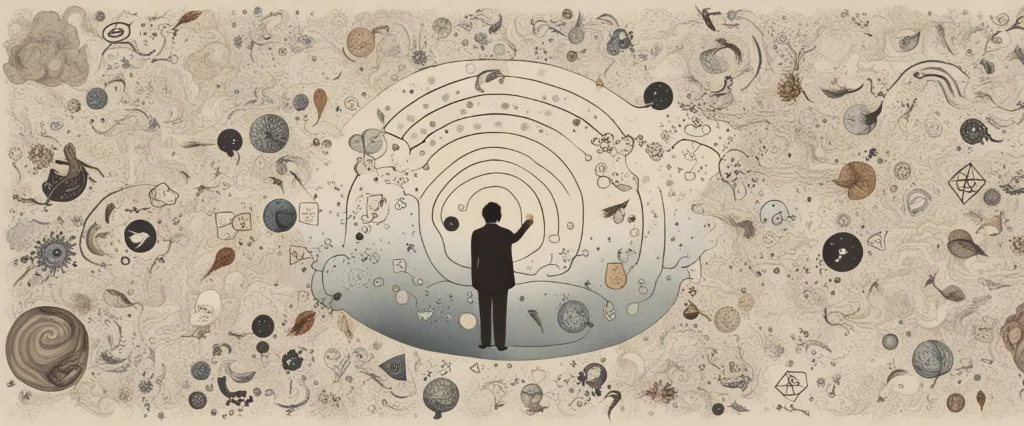
Books possess an exceptional power, whisking us away to realms uncharted and embarking us on intellectual voyages that expand our understanding of the world. In the realm of science and health, two fascinating literary marvels have emerged, offering unique insights into the intricate workings of our bodies. Ed Yong’s “I Contain Multitudes” and Michael Greger’s “How Not to Die” stand as invaluable contributions to the scientific literature, each captivating readers with their distinct perspectives on microbiology and nutrition.
I Contain Multitudes” places an illuminating spotlight on the vast ecosystems residing within our own bodies—the microbial communities that shape our health and influence our every function. In contrast, “How Not to Die” expertly navigates the complex maze of nutrition and unveils evidence-based research that aims to empower individuals to live a long and vibrant life. As such, studying both works side by side offers a unique opportunity to delve into the intricate ways our internal and external environments interplay and impact our overall well-being.
The purpose of this comparative study is to explore and analyze the distinctive features, scientific approaches, and core messages conveyed by Ed Yong’s “I Contain Multitudes” and Michael Greger’s “How Not to Die.” By examining these works, we aim to discover parallels and divergences in their perspectives, determining how these books contribute to the growing body of knowledge surrounding human biology, health, and the significance of our relationship with microorganisms and food.
To conduct this comparative study, we will adopt a multifaceted approach, encompassing thorough reading, critical analysis, and systematic examination of the narratives presented by Yong and Greger. By scrutinizing the authors’ style, tone, choice of examples, and incorporation of scientific evidence, we intend to unravel the underlying motivation behind their work and the impact they seek to impart on readers. Through this process, we aim to identify not only the strengths and weaknesses of their respective arguments but also potential areas of convergence, allowing us to outline a comprehensive understanding of the symbiotic relationship between our inner ecosystems and the food we consume.
It is anticipated that this comparative study will not only shed light on the extensive contributions made by Yong and Greger but also provide valuable insights into the importance of maintaining a balanced understanding of our bodies and making informed choices regarding nutrition. Through an in-depth examination of their work, we hope to inspire readers to embrace a holistic approach to health—one that appreciates the intricacies of our microbiota while optimizing nutrition to prevent and combat prevalent diseases.
“I Contain Multitudes” and “How Not to Die” are distinguished literary works with unique perspectives that delve into the captivating realms of human biology and health. By undertaking this comparative study, we anticipate unearthing the complementary and contrasting features exhibited by these books, while also gaining a deeper comprehension of the intricate interplay between our microbiomes and dietary habits. Delving into the multifaceted world of microbiology and nutrition revealed by Yong and Greger promises to be an exhilarating journey, fostering a more comprehensive understanding of our remarkable, interconnected selves.
Brief Summary of Two Books
I Contain Multitudes by Ed Yong
“I Contain Multitudes” by Ed Yong is a fascinating exploration of the microbial world that exists within and around us. The book delves into the intricate and often surprising relationships between humans, animals, and the trillions of microbes that call our bodies home.
Yong introduces us to the diverse range of microbes that inhabit our gut, skin, and other organs, highlighting their importance in maintaining our health. He emphasizes that these microscopic organisms play a crucial role in our immune system, digestion, and even our mental well-being.
The author demonstrates how our microbiomes are shaped by various factors such as genetics, diet, and environmental influences. He dispels common misconceptions about the dangers of microbes and instead emphasizes their essential contributions to our ecosystem. Yong reveals how studies on microbes have helped to develop innovative treatments for diseases and the potential they hold for future medical breakthroughs.
Moreover, the book also examines the complex symbiotic relationships between microbes and other species. From the mysterious glowing bacteria in squids to the role of bacteria in helping animals acquire new traits, the author unveils the interconnectedness of life on Earth.
“I Contain Multitudes” offers a nuanced and thought-provoking perspective on our relationship with the microbial world. It highlights the interdependence between humans, animals, and microbes, urging us to view these organisms not as foreign invaders but as essential partners in the intricate tapestry of life.
How Not to Die by Michael Greger
“How Not to Die” by Michael Greger is a comprehensive guide to adopting a plant-based diet and lifestyle to prevent and even reverse chronic diseases. Greger, a physician, nutrition expert, and founder of the website NutritionFacts.org, presents scientific evidence, backed by extensive research, to demonstrate how certain dietary choices can greatly impact our overall health.
The book is divided into two sections: the first focuses on the leading causes of preventable diseases, such as heart disease, cancer, and diabetes, while the second provides practical advice on implementing a plant-based diet and lifestyle. Greger introduces the concept of the “Daily Dozen” which consists of twelve food groups that he recommends consuming every day for optimal health.
Throughout the book, Greger emphasizes the power of food as medicine, showcasing numerous studies and clinical trials that support the idea that diet can significantly impact our health outcomes. He dismantles common misconceptions about nutrition, such as the belief that animal products are necessary for proper nutrition, and provides clear explanations of complex scientific concepts.
In addition to the dietary aspect, Greger also discusses the importance of exercise, stress management, and sleep in maintaining good health. He offers practical tips on how to make healthier choices when eating out, and provides guidance on grocery shopping and meal planning.
“How Not to Die” serves as a comprehensive resource for individuals seeking evidence-based information on how to prevent chronic diseases and lead a healthier life. With its accessible writing style and extensive scientific references, the book empowers readers to make informed choices and take control of their health.
Comparison between Two Books

Similarities in Body Health
In both “I Contain Multitudes” by Ed Yong and “How Not to Die” by Michael Greger, there are several similarities when it comes to discussing body health. Both books emphasize the importance of understanding the complex interactions within our bodies and the impact they have on overall health. Here are some key similarities between the two books:
1. The Influence of Microbes: Both books highlight the crucial role of microorganisms in our bodies and the various ways they affect our health. Ed Yong extensively discusses the microbiome – the collection of microorganisms living in and on our bodies – and its impact on digestion, immune response, and disease prevention. Similarly, Michael Greger explores the microbiome’s role in maintaining a healthy gut and its implications for overall well-being.
2. Diet and Health: Both authors emphasize the link between diet and body health. Michael Greger’s book specifically focuses on plant-based nutrition, advocating for a diet rich in fruits, vegetables, whole grains, and legumes to prevent chronic diseases. Ed Yong also touches upon the effect of diet on the microbiome, explaining how the food we consume influences the composition and activity of the microbial communities living in our bodies.
3. Chronic Diseases: Both authors discuss the prevention and management of chronic diseases. Michael Greger’s book delves into how dietary choices can reduce the risk of conditions like heart disease, diabetes, and certain types of cancer. Ed Yong explores the role of the microbiome in immune-related diseases, such as allergies, asthma, and autoimmune disorders, highlighting the connection between microbial imbalance and these conditions.
4. Holistic Approach: Both books take a holistic approach to body health, considering the interconnectedness of various bodily systems and their impact on overall well-being. They emphasize that maintaining good health requires understanding the intricate interactions between our microbiome, diet, lifestyle, and genetics, rather than focusing on isolated factors.
5. Science-Based Approach: Both authors rely on scientific research and evidence to support their claims. They present a wealth of studies and discuss the findings in an accessible manner, ensuring that the information provided is grounded in scientific knowledge.
6. Advocacy for Personal Responsibility: Both books inspire readers to take charge of their own health. Michael Greger encourages individuals to make mindful choices when it comes to nutrition, while Ed Yong emphasizes the importance of understanding our body’s microbial world to make informed decisions about our health.
Overall, “I Contain Multitudes” and “How Not to Die” share a common ground in their understanding of body health, emphasizing the significance of factors such as microbiomes, diet, chronic disease prevention, and adopting a holistic and science-based approach to personal well-being.
Divergences in Body Health
“I Contain Multitudes” by Ed Yong and “How Not to Die” by Michael Greger both delve into the topic of body health, yet they approach it from different angles and with varying emphases. While both books aim to promote good health and longevity, their divergences lie in the exploration of the human microbiome and the specific dietary recommendations they offer.
In “I Contain Multitudes,” Ed Yong provides a comprehensive exploration of the human microbiome, highlighting the intricate ecosystem of microorganisms that reside within the body. He discusses how these microorganisms play crucial roles in our health, from aiding in digestion and nutrient absorption to influencing our immune system and mental well-being. Yong emphasizes the importance of understanding and nurturing the diverse microbial communities within us, advocating for a holistic approach that considers the complex interactions between host and microbiome.
On the other hand, “How Not to Die” by Michael Greger primarily focuses on plant-based nutrition and its impact on preventing and reversing chronic diseases. Greger argues that a whole-food, plant-based diet is key to achieving optimal health and reducing the risk of various ailments and conditions. He presents evidence-based research on the benefits of consuming a range of plant foods, such as fruits, vegetables, legumes, and whole grains, while discouraging the consumption of animal products and processed foods.
While both books discuss the importance of diet in maintaining good health, they differ in their specific dietary recommendations. While Yong acknowledges the role of diet in shaping the microbiome, he does not provide a singular blueprint for what constitutes an ideal diet. Instead, he highlights the individuality of each person’s microbiome and suggests that a varied, fiber-rich diet is generally beneficial for nurturing a healthy microbial community.
In contrast, Greger’s “How Not to Die” takes a more prescriptive approach, promoting a whole-food, plant-based diet as the optimal choice for body health. He emphasizes the avoidance of processed foods and animal products, presenting scientific evidence that supports his recommendations.
Overall, the divergence between “I Contain Multitudes” and “How Not to Die” lies in their differing areas of focus and dietary recommendations. While Yong explores the intricate world of the microbiome and the importance of its diversity, Greger emphasizes the benefits of a plant-based diet to achieve optimal health. Both books contribute valuable insights to our understanding of body health, providing readers with different perspectives and approaches to improve and maintain their well-being.

Conclusion
Both “I Contain Multitudes” by Ed Yong and “How Not to Die” by Michael Greger are highly regarded books in their respective fields. The choice between them depends on your interests and what you are looking to gain from reading.
“I Contain Multitudes” explores the fascinating world of microorganisms and their impact on every aspect of life, including health, disease, and the environment. Ed Yong masterfully weaves scientific research and storytelling to engage readers with a captivating narrative about the hidden world of microbes. If you have an interest in biology, microbiology, or are simply curious about the intricate inner workings of the world, “I Contain Multitudes” would be a worthy choice.
On the other hand, “How Not to Die” by Michael Greger offers valuable insights into nutrition, health, and disease prevention. Driven by evidence-based research, Greger presents a comprehensive guide to a plant-based diet and lifestyle choices that can help prevent and reverse chronic diseases. If you are interested in health, nutrition, and improving your overall well-being, “How Not to Die” is a highly recommended read.
Ultimately, the more worthy book depends on your personal interests. If you are fascinated by the microbial world and want to dive into that subject, “I Contain Multitudes” is the better choice. However, if you are seeking practical advice and scientific knowledge regarding healthy eating and disease prevention, “How Not to Die” would be more suitable.

